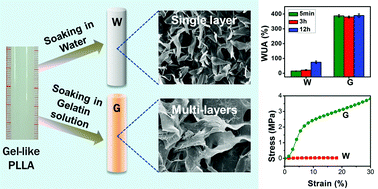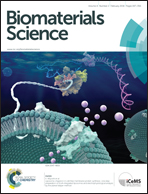A convenient process to fabricate gelatin modified porous PLLA materials with high hydrophilicity and strength†
Abstract
PLLA porous materials with high porosity were prepared by a gradual precipitation method and further modified by using different concentrations of gelatin aqueous solutions. Therefore, porous materials with different contents of gelatin coating were obtained. The micro morphology, crystallization, thermal performance, hydrophilicity and mechanical properties of the materials were evaluated by scanning electron microscopy (SEM), differential scanning calorimetry (DSC), X-ray diffraction (XRD), thermogravimetric analysis (TGA), water uptake ability tests and compression tests. It was found that the modified materials were formed by the stacking of nanosheets. The materials can maintain more than 80% porosity, high water uptake abilities and fast water uptake rates after modification. The compressive moduli of the materials were significantly improved from the initial sample with a value of 0.57 MPa to 46.41 MPa with gelatin modification. Due to the high porosity of materials, interconnected pore structures, and good surface hydrophilicity, the materials were expected to be widely used in the field of tissue engineering scaffolds, especially for bone substitutes, mainly due to their tunable and excellent mechanical properties.


 Please wait while we load your content...
Please wait while we load your content...